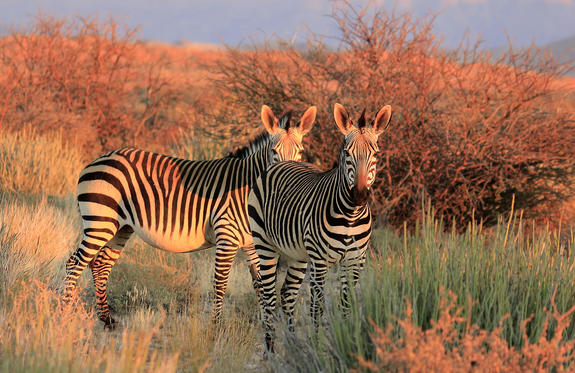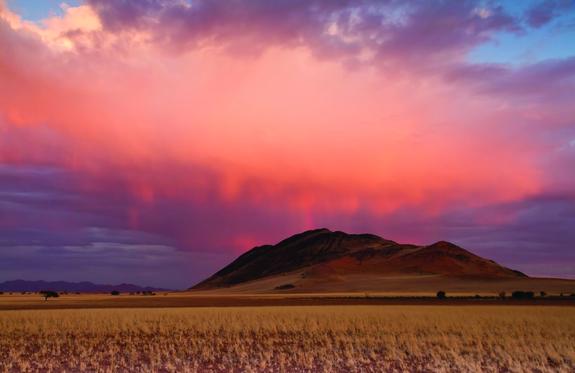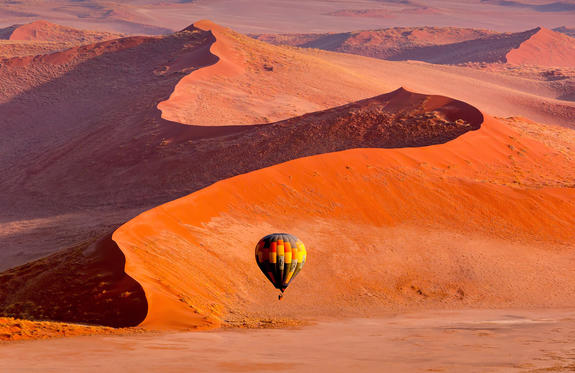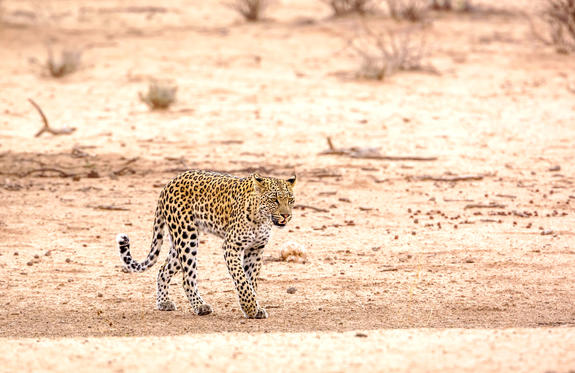
Originally called Olijvenhoutsdrift, the historic town of Upington is set in the Northern Cape Province of South Africa. The Orange River Valley runs through the harsh and mysterious Kalahari landscape that surrounds Upington and it becomes obvious why this area is known as the Green Kalahari, with fertile valleys contrasted against semi-desert. Upington offers lush manicured gardens, stately trees lining wide boulevards and colourful flowers, creating a sense of peace and serenity. Meanwhile, the town’s bustling business centre provides visitors with more lively entertainment. Upington serves as the gateway to the impressive Augrabies Falls and to the expansive wilderness of the Kgalagadi Transfrontier Park. Visitors can learn about local history at the Kalahari Orange Museum, enjoy wine tasting at the local Orange River Wine Cellars, or take a sunset cruise down the Orange River on a floating bar.
Namibia, a timeless Adventure
“A land of contrast & dramatic beauty - exuding a timeless appeal. From awe-inspiring landscapes combined with untamed wildlife, it’s a boutique bucket list destination.”
In south western Africa lies a land of compelling fascination. A land for those who worship at the shrine of Africa at its most resplendent, but also at its most unconventional. This is Namibia.
Described by the bushman as the “Soul of the World”, Namibia is rugged, natural, soulful and liberating. While the forces of nature have been fierce and unforgiving, they have also been bountiful. In this cauldron of heat and relentless force, God has created landscapes that are paralleled in their beauty only by the most exquisite diamonds found here. Imagine huge canvasses, uninhibited by man’s limitations, splashing swathes of colour of the monumental, star shaped dunes of the Namib Desert and the surreal Salvador Dali’esque Deadvlei, with its white clay pans, red dunes and blue skies. The awe-inspiring mountain ranges of some of the last true wilderness areas in Damaraland and the forlorn, windswept skeleton coastline. As all Africa, Namibia has abundant wildlife in our National Parks as well as the large tracts of land which lie unfenced and unfettered for wildlife to traverse. Much of this land has been made available to the local communities, and both these, as well as private land of many farmers who have banded together, have been declared as local conservancies. Namibia also has the richest succulent flora in the world, harbouring about one-third of the world’s approximately 10,000 succulent species. Namibia is a melting pot of sights, sounds, aromas, tastes and emotions in abundance, just waiting to be experienced.
Namibia is home to the infamous Skeleton Coast, that forlorn and rugged coastline along the Atlantic Ocean. It is here where we find the Namib Desert, the World’s oldest desert and a World Heritage site, from which the country gets its name. The eastern expanses are dominated by the Kalahari Desert; the central highlands are renowned for its free-roaming wildlife and the Etosha National Park. Kaokoland and Damaraland are where we find some of the most dramatic landscapes, the uniquely adapted desert animals and the proud Ovahimba people. And to top it off – the contrast of the lush forest vegetation of the Zambezi region, part of the KAZA Transfrontier National Park. Like the diamonds mined here, Namibia is a true gemstone waiting to be discovered.
MAJOR ATTRACTIONS
Namibia’s appeal lies in its dramatic mix of spectacular landscapes, iconic cultures and African wildlife. The Namib Desert is home to the world’s highest dunes and oldest desert plant known to man. The Fish River Canyon is surpassed in size only by the Grand Canyon, while the 60 ton Hoba Meteorite is globally the largest of its kind. Namibia’s wildlife is exemplary and home to the Big 5, albeit, unlike a zoo, not found in one area. A great portion of Namibia falls under communal land, where the tourist can interact with age-old cultures such as the Himba, Damara and the Bushmen. Swakopmund, wedged between the Atlantic Ocean and the desert dunes and fondly known as Namibia’s playground, is a must for adventure and leisure tourists.
SEASONAL HIGHLIGHTS
Namibia is an all-year destination with over 300 days of sunshine. The dry winter months are generally better for game viewing and with clear cold skies, one of the world’s most sought after stargazing destinations. In wetter months, our green season, calving season commences and birding as well as botanical safaris are spectacular. The wide range of national parks ensure an unforgettable wildlife experience throughout the year.
ADVENTURE
Join expert rangers in Damaraland tracking desert elephant or black rhino, or experience the allure of the Namib Desert from a hot-air balloon. Hike the second largest canyon on earth, or learn first-hand survival practices from real Bushman while following them into the Kalahari. Watch dolphins and other aquatic animals on a catamaran cruise on the Atlantic Ocean or enjoy a roller coaster quad bike experience in the Namib Desert dunes.Enjoy your own self-drive adventure in national parks and untouched wilderness areas, meeting the cultures and relishing the freedom of endless space.
SHOPPING
All larger cities and towns offer high quality shopping and culinary experiences equal to European standards. While Windhoek’s high-end shopping malls are ideally suited to cater to all shopping needs, the centre of the city still offers streets where some smaller boutique style or owner managed outlets exist. Swakopmund has not yet acceded to the commercialism of malls and the town is still built around a small centre of busy shops. These more laid-back small arcades and cafeterias, all reachable on foot, promote a relaxed holiday atmosphere. Throughout Namibia guests can stop at informal markets en-route to their next destination to shop for wooden souvenirs, minerals, clothing or even traditional food.
DID YOU KNOW?
- Namibia has the highest concentration of Cheetahs on earth
- Namibia is the second least populated country
- 46% of Namibia’s surface area is under conservation management
- The entire coastline of Namibia is protected by national parks
- Etosha national park boasts 114 different animal species

This region is typified by the Succulent Karoo. The distinctive climatic characteristics of the Succulent Karoo make it different from all other deserts in the world. Rainfall is reliable and predictable, falling mostly in winter, and prolonged droughts are rare. The Succulent Karoo’s botanical diversity is unparalleled by any other arid region on earth and is the world’s only plant hotspot that is entirely arid. This ecoregion is home to greater than 5,000 higher plant species, nearly 40 percent of which are endemic, and 18 percent of which are threatened. It has the richest succulent flora in the world, harbouring about one-third of the world’s approximately 10,000 succulent species. Other unique features include the diversity of miniature succulents (435 spp.) and geophytes (bulb-like plants 630 spp.). The ecoregion is also a center of diversity and endemism for reptiles and many invertebrate taxa, especially monkey beetles (Rutelinae: Hoplinii). The Namib Desert ecoregion to the north is characterized by extremely low and variable summer rain (less than 50 mm per year), and extremely sparse plant cover, dominated by ephemerals. To the east lies the Nama Karoo ecoregion, a low open shrubland with variable grass cover and highly variable rain that falls mainly in the late summer months.

A popular stopover for visitors travelling to Sossusvlei and the Duwisib Castle, Maltahohe was established when the District Commissioner of 1899 decided that an outpost further west of the vast, central Namibian district was required. Maltahohe is home to the oldest hotel in the country, equipped with its original bar, and a farm 35vkm north of the town that has an 800-hectare shallow pan that, after flooding, is carpeted by a blanket of colourful lilies for about a week before they are devoured by elephant nosed beetles.

With palm-lined streets, seaside promenades and fine accommodation for all budgets, Swakopmund is Namibia’s most popular holiday destination, and its pleasant summer climate and decent beaches attract surfers, anglers and beach lovers from all over Southern Africa. Thanks to its mild temperatures and negligible rainfall, Swakopmund generally enjoys grit in the oyster. When an easterly wind blows, the town gets a good sand-blasting, and almost perpetual drizzle. The fog rolls up to 30km inland and provides moisture for desert-dwelling plants and animals, including 80 species of lichen. For better or worse, Swakopmund feels overwhelmingly Teutonic – indeed, it has Germany – but for visitors, it’s a Namibia’s adrenalin capital, and offers a wide range of gut-curdling activities from sand boarding and quad-biking to skydiving and camel riding. Note, however, that it gets especially busy around Namibian school holidays in December and January, when temperatures average around 25ºC.

Pulsing with life, opportunity and a sparkle of adventure, Windhoek is a multicultural city characterised by tranquil co-existence and enough living space for all its citizens, which number 350’000. Visitors can enjoy the best of two worlds between the European-style architecture and lifestyle, to the vivid beat of African culture and environs. The first recorded settlements were established because of the springs in the area. In about 1842, the Oorlam Kaptain, Jan Jonker Afrikaner, settled in at the strongest spring in the present Klein Windhoek. At the time, the place was called “/Ai-//Gams” (Fire Water) by the Namas, and “Otjomuise” (Place of Steam) by the Hereros, both names bearing references to the hot springs. The German colony came into being with the determination of its borders in 1890. Germany sent a protective corps (the “Schutztruppe”) under Major Curt von Francois to maintain order; the garrison was stationed at Windhoek, where it was strategically situated as a buffer between the Namas and Hereros, while the twelve strong springs provided water for the cultivation of food. The present Windhoek was founded on 18 October 1890 when Von Francois laid the foundation stone of the fort, which is known as the Alte Feste (Old Fortress). Windhoek has a rich cultural life where activities happily mix and match to produce some interesting combinations.The “township” of Katutura is an journey for discovering the sounds and smells of Africa. The highlight is a visit to the Tukondjeni Market, which offers services that satisfy many community needs. It’s a busy place, where one can purchase supplies and traditional Namibian food such as barbecued meat, dried fish, fried mopane worms (known as “omaungu”) and other traditional food such as “ombidi” and dehydrated wild spinach.
Botswana is well known for having some of the best wilderness and wildlife areas on the African continent. With a full 38 percent of its total land area devoted to national parks, reserves and wildlife management areas – for the most part unfenced, allowing animals to roam wild and free – travel through many parts of the country has the feeling of moving through an immense Nature wonderland. Botswana is a rarity in our overpopulated, over-developed world. Untamed and untameable, it is one of the last great refuges for Nature’s magnificent pageantry of life. Experience here the stunning beauty of the world’s largest intact inland Delta – the Okavango; the unimaginable vastness of the world’s second largest game reserve – the Central Kalahari Game Reserve; the isolation and other-worldliness of the Makgadikgadi – uninhabited pans the size of Portugal; and the astoundingly prolific wildlife of the Chobe National Park. Botswana is the last stronghold for a number of endangered bird and mammal species, including Wild Dog, Cheetah, Brown Hyena, Cape Vulture, Wattled Crane, Kori Bustard, and Pel’s Fishing Owl. This makes your safari experience even more memorable, and at times you will feel simply surrounded by wild animals. The first – and most lasting impressions – will be of vast expanses of uninhabited wilderness stretching from horizon to horizon, the sensation of limitless space, astoundingly rich wildlife and bird viewing, night skies littered with stars and heavenly bodies of an unimaginable brilliance, and stunning sunsets of unearthly beauty. As well, with more and more cultural tourism options on offer, you will be charmed by the people of Botswana, visiting their villages and experiencing first-hand their rich cultural heritage. But perhaps most of all, Botswana’s greatest gift is its ability to put us in touch with our natural selves. It offers that vital link so keenly felt by inhabitants of the developed world, a pervasive void we feel but often cannot name – our connectedness with Nature and the astonishing diversity of plants and animals to be explored.

Flanked by Ghanzi in the north and Sekoma in the south, the quiet Kalahari Desert town of Kang provides a relaxing base from which to explore Northern Botswana, Namibia, the Kgalagadi Transfrontier Park and the Central Kalahari Park. The remote village is strikingly scenic, providing many interesting hiking and photographic opportunities in its vast stretches of flowering plains, ochre desert hills and enormous, strangely-shaped baobab trees. One of the major drawcards of the area is the variety of thrilling game drives offering the possibility of spotting cheetah, leopard and many different types of game species. After an exciting day on safari, don’t miss the opportunity to take a refreshing dip in one of the swimming pools at Twee Rivieren, Kalahari Tent, Mata Mata and Nossob camps at the nearby Kgalagadi Transfrontier Park.



